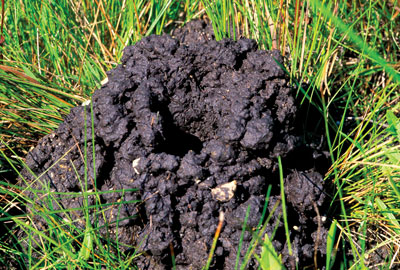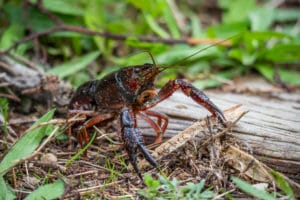Was that a lobster!?
If you spot a mini lobster crawling across your lawn, chances are you stumbled upon a crayfish. Like lobsters, crayfish are crustaceans that belong to the order Decapoda (a group that also includes crabs and shrimp). Both lobsters and crayfish have hard exoskeletons, ten legs, a pair of pincers, and are delectable when boiled and served with butter (although you will find a single crayfish is more of a morsal than a dinner). Unlike their marine cousins, however, crayfish are freshwater invertebrates, with over 700 species found around the world. While a crayfish might look out of place in your yard, eight native crayfish species call Michigan home, and you can find most of them right here in the Huron River watershed!
Michigan’s native crayfish and where to find them
Primary burrowers

Crayfish are burrowers that dig tunnels in soft sediments in or near freshwater. While all of Michigan’s native crayfish are in the Cambaridae family, species can be categorized as either primary, secondary, or tertiary burrowers.1 Primary burrowers dig complex networks of tunnels in ditches, wet meadows and prairies that extend as far down as the water table. While primary burrowers spend most of their life underground, you may see them trekking across fields or lawns on a rainy day. Primary burrowers play an important role in Michigan’s ecosystems, as their networks of tunnels aerate soils and provide habitats for other native species. Michigan’s native primary burrowers include the painted mudbug (Lacunicambarus polychromatus), the devil crayfish (Lacunicambarus diogenes), and the digger crayfish (Creaserinus fodiens).1
Secondary burrowers
Secondary burrowers build tunnels that are generally connected to rivers, lakes, or wetlands. While these crayfish spend most of their time in the water in the warmer months, they use their burrows to hide from predators and escape cold temperatures or drought conditions. Michigan’s secondary burrowers include the white river crayfish (Procambarus acutus) and the calico crayfish (Faxonius immunis).1
Tertiary burrowers
In contrast to primary and secondary burrowers, tertiary burrowers live the entirety of their life in the water, rarely digging burrows unless they are hiding temporarily beneath rocks or other hard substrates. These crayfish prefer fast flowing riverine habitats, where they serve as both predators of fish eggs and macroinvertebrates, and as an important prey species for fish, birds, and mammals. The big water crayfish (Cambarus robustus), northern clearwater crayfish (Faxonius propinquus), and northern crayfish (Faxonius virilis) are Michigan’s tertiary species.1
Invasive crayfish threaten native ecosystems
While native crayfish are vital to Michigan’s natural communities, two additional crayfish species, the rusty crayfish (Faxonius rusticus) and the red swamp crayfish (Procambarus clarkii), are considered invasive in the state. Invasive species are plants or animals that have been introduced to a region where they did not evolve and lack natural competitors to keep populations in check. Invasive species can outcompete native species for resources, suppress native populations through predation, and ultimately degrade habitats.
Native to the Ohio River basin, rusty crayfish have proliferated across much of the US and are now abundant in the Great Lakes region. Rusty crayfish are tertiary burrowers, living their entire life in rivers and lakes. Larger than native crayfish species, they outcompete native species for food and territory, and alter habitats and prey dynamics through consumption of aquatic plants and fish eggs. Rusty crayfish can be found in the Great Lakes as well as many inland lakes and rivers across Michigan’s northern and lower peninsulas, including in the Huron River watershed.1
Red swamp crayfish, a new invader
While the rusty crayfish has been in Michigan for some time, the red swamp crayfish is a new invader that we need to be on the lookout for in the watershed. Discovered in southern Michigan in

2017, efforts are currently underway to reduce red swamp populations and control further spread. Native to the Mississippi River drainage and the Gulf Coast, Red Swamp crayfish (or crawfish, as they are locally known) are an iconic southern species and staple of bayou cuisine. From delectable crawfish etouffee to the famous crawfish boil, these crustaceans are both culturally significant and economically valuable.
Yet outside of their native range, the red swamp crayfish can be a destructive addition to freshwater ecosystems. Veracious predators, red swamp feed on fish and amphibian eggs and outcompete native crayfish for prey and territory. Due to the species’ extensive burrowing, high densities of red swamp crayfish can erode and destabilize banks, increase sedimentation, degrade water quality, and even cause the collapse of dams and levees. As secondary burrowers, red swamps are also highly adaptable to changing environmental conditions and can proliferate in a diverse range of habitats, surviving droughts and temperature shifts in their shallow burrows.1
What’s happening now
Currently, isolated populations of red swamp crayfish exist in several southeast Michigan water bodies. Numerous studies are being conducted to determine how red swamp were first introduced, the mechanisms with which they could spread, and the best ways to control or destroy existing populations. Due to the danger red swamp crayfish pose to Michigan’s aquatic ecosystems, they have been listed as a prohibited Watch List Species, meaning it is illegal to possess, sell, or trade live red swamp in the state.
What you can do to help
While there have been no verified sightings of red swamp crayfish in the Huron River watershed, it is crucial that community members keep their eyes out for this dangerous invader! If you think you may have sighted a red swamp crayfish, take a picture, and contact the Michigan Department of Natural Resources Fisheries Division. Mature red swamp crayfish really look like tiny lobsters! They are bright red in color, with raised red bumps along their claws and backs.
Visit Michigan.gov/invasives to learn more about how to identify and report red swamp crayfish sightings or contact HRWC. Do your part to keep our watershed healthy!
Source: Michigan Department of Natural Resources, 2020, Field Guide to Michigan Crayfish.
This blog post was originally published June 1st in the Huron River Report, Summer 2021.



